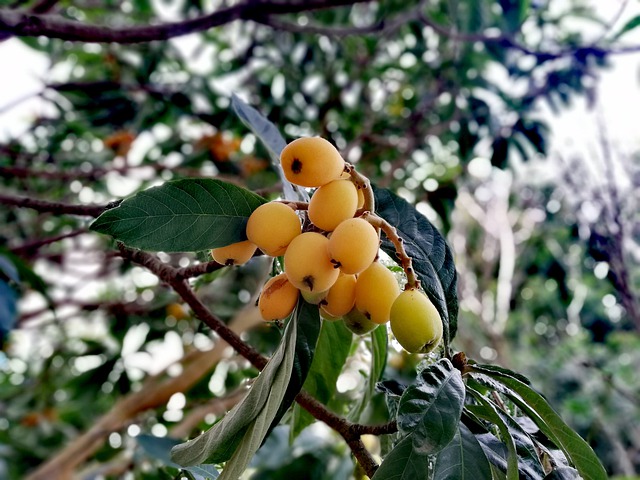How to Grow a Loquat Tree from Seeds
Let’s find out how to grow tree a loquat from seed.
They are kind of like a sweet, citrusy fruit that’s as beautiful to look at as it is to eat. Native to China and now enjoyed worldwide, these golden balls grow in clusters on bushy trees, making them a unique addition to any garden.
But here’s the best part: you don’t need to be a seasoned gardener to grow your own loquat tree. With just a few seeds, a little patience, and the right conditions, you can start growing your own loquat tree from scratch.
I had also never tried to grow loquats before, so this is completely new for me, and quite honestly, I’m following a few tips that I found on the internet.
The loquat fruit is a fleshy fruit that turns, ironically, an apricot colour when it is ripe, and its usually ready to start picking in spring. Inside, the fruits contain 2 or 3 large brown pips that you can then replant.
Can You Eat Loquats?
So, can you eat loquats?
Yes, you can eat loquats, and they’re delicious! These sweet, tangy fruits are perfect for snacking straight off the tree or you can use them to make a variety of treats such as jams, salsas, teas, or even desserts.
** Just be mindful that while the fruit is edible, the seeds and leaves contain small amounts of toxins so don’t eat that **
But if you have a lot and want to make something extra, try some of these:
* Loquat tea
* Loquat salsa
* Loquat chutney
* Loquat marmalade
* Loquat jam
* Loquat sorbet
* Loquat crumble
* Loquat liqueur
* You can even use them to create a fruity summer cocktail!
About My Little Loquat Experiment
Today is the 09th August 2021
I am in South Africa; it is August and so it is winter. Unfortunately, I cannot tell you about zones because we don’t have those here like the USA.
The average temperature at the moment is hanging around the 13 – 15 degrees Celsius mark, but today it is sunny (15 degrees) with no wind at the moment.
I also think that the seasons are a bit confused as some of the trees already have spring blossoms on them, but it isn’t actually warm enough for that yet.
How to Collect and Prepare Loquat Seeds
My neighbors have a loquat tree which hangs over into our garden, so I just I picked a few loquats that were hanging over the wall. They are not 100% ripe but they are turning yellow, they just need a little bit more time to become that golden apricot color.
So, if this doesn’t work, I will wait a bit longer until the fruit is ripened, and I’ll try again.
It’s easy to get the seeds out. Just pull the fruit apart gently and pop out the seeds. Some fruit had two seeds while others had only one loquat seed.
The seeds are easy to work with as they are large, brown and a little bit slimy, so they pop out of the fruit very easily. I read that you shouldn’t let the seeds dry out like you do with butternut seeds, so I left them as is and got ready to sow.
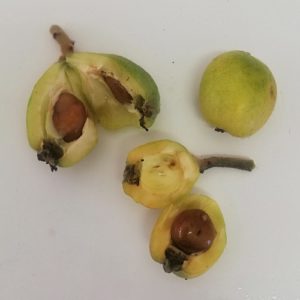 These are some of the loquat fruits that I picked from the tree today.
These are some of the loquat fruits that I picked from the tree today.
They are slightly yellow, slightly green still and you can see the large, round brown seed easily.
I haven’t eaten loquats in years so I can’t actually remember what they taste like, but they are originally from China and are supposed to be sweet, with a yummy splash of citrus.
I’ll have to wait until the loquats on our neighbor’s tree ripen and then do my own taste-tester!
Preparing the Soil to Plant your Loquat Seeds
Part of gardening is experimental, and this makes it fun and interesting. When I decided I wanted to learn how to grow a loquat tree or two from seeds, I decided I want to test two methods to see if one way produced better results than the other.
a) Soilless growing medium
I filled my seedling tray approximately a third of the way with coconut coir, a handful of vermiculite, and approximately one tablespoon of bone meal. Organic gardening all the way!
Admittedly I am not the best at measuring out things when it comes to gardening, perhaps that is why some of my projects don’t work, but it’s all part of the experimentation part.
The internet instructions said to wet the coconut coir and once that was done I laid 20 loquat seeds on top of this. The loquat trees will not be growing here; I am just using this method to try and germinate them. Once that was done, I covered the seeds with approximately an inch of the same medium and watered them again.
b) Soil
The second container was much smaller. I put stones in the bottom of the pot for drainage, then filled it with potting soil from the nursery/ garden centre, plus compost from my compost heap, and a sprinkle of bone meal.
I laid the three seeds on top, gently covered them with more soil, and then watered them.
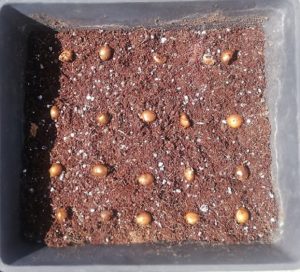
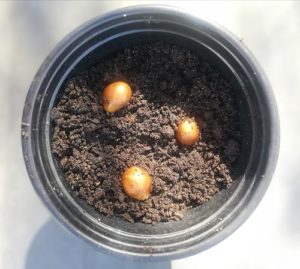
And lastly, I took them and put them in my room. Yip, my bedroom.
They are now sitting there on the stand against the north-facing window (I’m in the southern hemisphere), as it currently gets the most sun during winter. I have put both of these containers there, in the sun, and have protected them from the cold and the rain that’s supposed to be coming.
Here are some pointers that I collected from the internet before I got started:
- It will take between 6 – 8 years from seed, for the loquat tree to produce fruit. Sometimes 10.
- Apparently, you should graft them when the base of the tree is 1 1/2 inches in diameter. I am not entirely sure why at this stage, so I will look into it. Maybe it produces better edible fruit?
- They are not fussy plants, and you can grow them in alkaline or acidic soil.
- Fertilize three times a year with lawn fertilizer that does not contain weed killers.
- Plant seeds straight away and don’t let them dry out otherwise the plant embryos will die.
- Put them in a soilless medium of 1/2 part vermiculite or perlite, 1/2 part coconut coir, and 1 teaspoon of bone meal. Cover with an inch of the medium.
- Place in a bright, warm environment (approximately 21 degrees C/ 70F). Keep moist.
- When they are 6 inches tall they can be transplanted into their own pots.
- Look up transplanting and grafting when ready to transplant.
UPDATE: 23rd August 2021
Nothing’s happened yet!
UPDATE: 15 December 2021
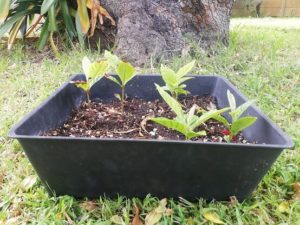 Almost four months have passed and now I have sprouting loquat seeds, so a few small trees are growing. At least I figured out that ‘how to grow loquat tree from seeds.’
Almost four months have passed and now I have sprouting loquat seeds, so a few small trees are growing. At least I figured out that ‘how to grow loquat tree from seeds.’
Only a few from the original seeds sown have survived, although I did move houses and they went through a bit of stress.
These mini loquat trees are getting large enough to transplant into their own larger containers and they also need more nourishment through the soul to provide them with everything they need to develop strong root systems and trunks.
Loquat trees prefer loamy soil that drains well and the great thing is it doesn’t have a preference for acidic or alkaline soil.
UPDATE: August 2023
Too much has happened in this time, and I had left all of my plants at my father’s house. I need to go and fetch them; I can’t remember if the loquats had survived. But at this time, you now have an idea how to germinate these yourself and start to grow your own loquat from seeds.
Caring for Your Loquat Tree
Once your loquat tree is established, proper care will ensure it thrives and produces an abundant harvest of sweet, citrusy fruits. Here’s what you need to know about nurturing your loquat tree:
1. Sunlight
Loquat trees thrive in full sun, so choose a location that receives at least 6-8 hours of direct sunlight daily. While they can tolerate partial shade, optimal sunlight promotes better fruit production and overall growth.
2. Watering
Loquats prefer consistent moisture, especially during their growing and fruiting seasons. Water deeply once or twice a week, depending on the climate and soil type, ensuring the soil stays moist but not waterlogged. Reduce watering during the dormant season.
3. Soil and Drainage
These trees aren’t too fussy about soil types, as long as it drains well. Loamy soil enriched with organic matter is ideal. If you notice water pooling around the roots, consider improving drainage or planting in raised beds.
4. Fertilizing
Feed your loquat tree three times a year—spring, summer, and fall. Use a balanced fertilizer with nitrogen, phosphorus, and potassium to promote healthy growth and fruit production. Avoid fertilizers with weed killers, as they can harm the tree.
5. Pruning
Regular pruning helps maintain the shape and size of your loquat tree while improving air circulation and sunlight exposure. Remove dead or damaged branches, and thin out crowded areas to prevent disease and pests. Prune after harvesting fruit to avoid cutting off new flower buds.
6. Pest and Disease Management
Loquats are relatively hardy but can occasionally attract pests like aphids, scale, or fruit flies. Inspect your tree regularly and treat infestations with organic insecticides or neem oil. For diseases like fire blight, remove infected branches promptly to prevent the spread.
7. Harvesting
Loquat fruits ripen in clusters and should be harvested when they turn a rich, golden apricot color. Handle them gently to avoid bruising, as ripe loquats are delicate.
By following these care tips, your loquat tree will not only be a beautiful addition to your garden but also a reliable source of delicious, homegrown fruit for years to come.
FAQs
Do Loquats Grow Well in Containers?
Yes, loquats can grow well in containers, especially if you’re limited on space or want to grow them on a patio or balcony. Choose a large, deep container with good drainage to accommodate the tree’s root system. Make sure to use well-draining potting soil, and be prepared to transplant the tree into a larger pot as it grows. Regular pruning and root management will help keep the tree healthy and encourage fruit production.
How Long Do Loquat Trees Live?
Loquat trees are known for their longevity, often living 20 years or more when properly cared for. Some trees may even reach 50 years of age, producing fruit for many seasons. With good care, including proper watering, sunlight, and pruning, your loquat tree can be a long-lasting, fruitful addition to your garden.
Can Loquat Trees Tolerate Frost?
Loquat trees are sensitive to frost and can suffer damage when exposed to freezing temperatures. While they can tolerate brief, light frosts, prolonged exposure or hard freezes can kill flowers, damage young growth, and stunt overall development. In colder climates, consider growing loquats in containers so they can be moved indoors or to a more sheltered location during winter months.
